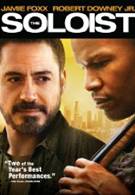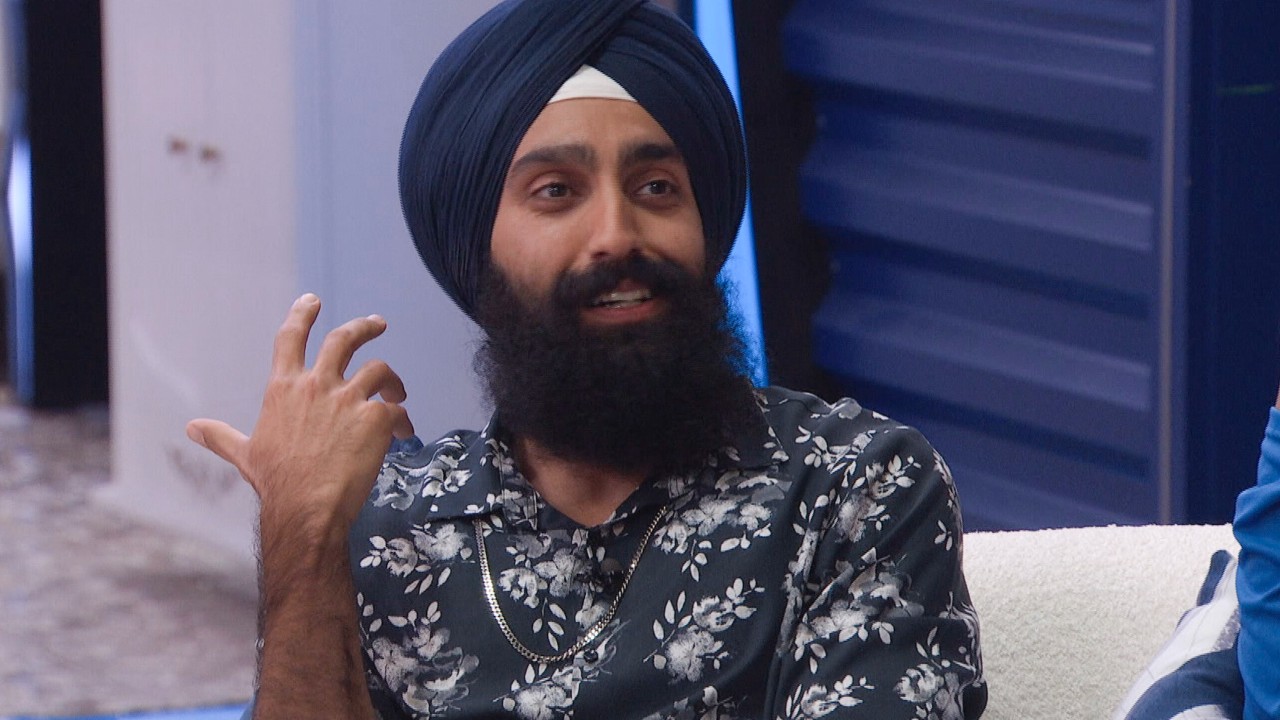The Soloist is a love story about obsessive preoccupations, with classical music as a central focus. It's also about homelessness, mental disorder, cultural bias, faith, hope, and charity. No romantic love. All the trappings of heavy-handed Oscar fodder, yet it rarely becomes that kind of movie. Nowhere near as schmaltzy as I expected, the film has a strong cast whose performances both gloss over and call attention to the weaker elements of the source material. The Soloist is based on a series of articles written by L.A. Times columnist Steve Lopez (Robert Downey, Jr.) about Nathaniel Ayers, Jr. (Jamie Foxx), a Julliard-trained musical savant whose impending schizophrenia drove him to living on the streets of Los Angeles. It's inspiring and discouraging all at once, a testament to the film keeping its head above melodramatic waters. Oh, and the movie's title doubly refers to both the musical term "soloist" and the fact that Ayers forces himself to live his life alone. Take that, literal movie titles like Prom Night and E.T. This is Jamie Foxx's second showcase role as a non-fictional musician, and it's Robert Downey, Jr.'s second role as a non-fictional news writer. This movie feels like it should have come before those earlier roles. It could be because Ray Charles and The Zodiac Killer are more fascinating subjects to me, or that afterwards I wished the movie had been about cult-fave Wesley Willis. But that would take away from the very interesting story of Nathaniel Ayers, Jr., whom I wasn't familiar with before the film was made. I also would not have learned about Steve Lopez, the main reason anybody knows about Ayers. The Soloist's shortcomings stem from its existence as a movie at all, which I will duly explain.
We meet Lopez as he gets into a minor bicycle accident marring one side of his face. The opening is very breezy and sets you up for a movie that may resemble Downey's Kiss Kiss, Bang Bang, down to the (article dictation) narration. The very appearance of the film's title is understated and personal. It in no way makes you believe grandiose music sequences are to follow. Steve writes about his accident, and from this we are introduced to his career at the Los Angeles Times, housing a vastly under-used Stephen Root and a standard Catherine Keener. Keener plays Mary Weston, Lopez's ex, but it's only a movie quirk. In real life, the two are happily married. Director Joe Wright explains the role was originally small but was fleshed out when Keener signed on. I'm assuming the couple was separated in the movie to give Steve Lopez a pronounced goal and through-line. Expanding a pseudo-false existence just to give your main character something to do is not an exceptional approach to plotting. But it's Catherine Keener. She brought realism to Death to Smoochy. Surely she can save a marriage that never seems all that strained to begin with.
Lopez stumbles upon Foxx's Nathaniel as he plays a two-stringed violin beneath a statue of Beethoven, who serves as Nathaniel's personal idol. He wears layers of second-hand clothing and lugs around an overstuffed shopping cart of junk. The two talk, and it's obvious Nathaniel's screws are pretty loose. He speaks in repetitious phrases, often in a manner resembling word-association exercises. Lopez discovers he's a Julliard drop-out and spends the rest of the movie trying to reform Nathaniel's hermit-like existence. Lopez's first column about him garners attention and, in one case, a used cello, the first instrument a young Nathaniel ever learned. Lopez gets him situated with LAMP, a community-based housing project, but Nathaniel has major issues with enclosed spaces, which are partially explained in uneven flashbacks pre-dating his mental unraveling. That the movie is centrally from Lopez's point of view makes these objective scenes feel tacked on, but then maybe there were literal descriptions of Nathaniel's breakdowns in the articles or subsequent book. If there were, I'm certain they weren't this hammy.
As further encouragement, Lopez sets up a private viewing of a L.A. Philharmonic practice session, which is a dream realized for Nathaniel. In scenes where he listens to music or is faux-playing his own instruments, Foxx's face sincerely delivers a lot of heart, contrasting his moments of anguish and rage, when his eyes genuinely seem to lack focus and reason. These are quirks that would complicate a less-talented actor's performance, but Foxx has it in his back pocket. This gradual anguish and rage hit peaks, particularly when Lopez attempts to take him from the openness of street life by securing an unwanted apartment. By this point, I was certainly glad Lopez's article narration was a motif, because I would have forgotten he had a job at all. Stay-at-home mothers don't show their children this kind of attention. I like to imagine he made his wages masterminding bum fights amongst all of the homeless people, many of whom were actual transients. Many of the skid row scenes were shot in their real locations. I would not have wanted to be the on-set caterer.
By the movie's ending (or non-ending, as is common for current-event adaptations), a vague serenity filled me. No saccharine-sweet twinge in my cheek muscles. I wasn't sick of seeing homeless people. I didn't learn any pseudo-science behind schizophrenia. For the most part, the film has a realistic edge that isn't so real that the story is smothered. The glaring exceptions to this are the pretentious music sequences. They're visually interesting, I guess, but serve only to detach the viewer and turn the film into a Beethoven-themed Across the Universe. Choreographed pigeons. A Pink Floyd-style laser show. If Michael Gondry or Spike Jonze wants to try this kind of thing, I'll allow it. But not the guy who made the most recent Pride and Prejudice. Though never overly impressive, the look of the film remains competent throughout. Joe Wright's direction is particular about how the characters are framed, which keeps scenes from becoming muddy or static. The anamorphic widescreen allows you to see about 700 more pieces of garbage than you would on regular TV. It's a very dirty movie in this respect. The film sounds great, more so if you're a fan of classical music, which I casually am. Again, it only fails miserably in scenes where Nathaniel acts out against the voices in his head, which sound like vocal exercises for Piper Laurie in Carrie.
There are quite a few special features. The film can be watched with director Joe Wright's commentary track, which stays light and insightful, complete with many, "I'm a British fish out of water in an L.A. wasteland" comments. There's a pretty decent making-of doc, "An Unlikely Friendship," which shares ample, though not enough, time with the actual Steve Lopez and Nathaniel Ayers, Jr. Both men are quite jovial, and it's interesting to witness their camaraderie. Ayers seems more coherent than Foxx plays him, but that's hardly worth mentioning. I truly believed in the friendship. The empathy Lopez exudes is rather touching. We see more of it in another short featuring them exclusively, "Kindness, Courtesy, and Respect." These few minutes made me want to read Lopez's articles more than the movie did. There are also generic deleted scenes, including an amusing hospital questionnaire read to Downey by an un-nurselike Jena Malone. And, of course, there are trailers.
The heavy hand that the movie avoided is present in "One Size Does Not Fit All: Addressing Homelessness in Los Angeles" and "Beth's Story." The first does exactly what its title suggests: lots of footage of the under-privileged, as well as light preaching from LAMP volunteers and other local social workers. The second is a short animation about Beth, who makes a financial mistake and ends up on the street, sick of asking for money. It has a similar feel to many anti-drug commercials.
Your Daily Blend of Entertainment News
It's strange that a movie can nail such a comfortable, balanced sentimentality, but fail in the area of its main character's plot progression. Essentially, Steve Lopez makes a friend and helps him out. I'm supposing he matures mentally, but it's not like he was a prick when the movie started. The modified relationship with Keener is contrived and useless. The movie may have worked better as a documentary, but without the marquee star power, it might not have reached a full audience. There are many reasons to see The Soloist when it comes to cable, but even though it's a good release, there are better DVDs to rent in the meantime.

Nick is a Cajun Country native and an Assistant Managing Editor with a focus on TV and features. His humble origin story with CinemaBlend began all the way back in the pre-streaming era, circa 2009, as a freelancing DVD reviewer and TV recapper. Nick leapfrogged over to the small screen to cover more and more television news and interviews, eventually taking over the section for the current era and covering topics like Yellowstone, The Walking Dead and horror. Born in Louisiana and currently living in Texas — Who Dat Nation over America’s Team all day, all night — Nick spent several years in the hospitality industry, and also worked as a 911 operator. If you ever happened to hear his music or read his comics/short stories, you have his sympathy.

